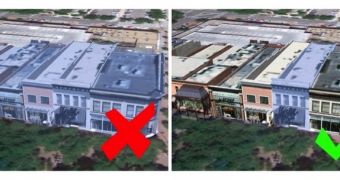Google has been working for years to add 3D buildings and objects to Google Earth and more recently to Google Maps. Well, volunteers and enthusiasts do much of the work, the actual 3D models, Google just takes care of the rest, provides the tools and decides which models get in and which don't.
Now the company is announcing a change in the way it reviews 3D models, there are some stricter rules, but they're also clearer, which Google believes will make it easier for those creating models to make sure their work gets in on the first try.
"It was over five years ago when we came up with the initial Acceptance Criteria for photo-textured 3D buildings in Google Earth," Jordan Van Wyk, 3D Modeling Specialist at Google wrote.
"Since then, we’ve learned many things and have also made many improvements to the 3D modeling process—including the release of Building Maker and two updated versions of SketchUp," he said.
"Given all of these changes, we realized that our Acceptance Criteria were due for an overhaul," he announced.
"Our new Acceptance Criteria have been completely rewritten with the goal of making them clearer and easier to follow," he explained.
Google has revised some of the sections that were most regularly misunderstood.
Google now requires that 3D models only have image textures for the roof and the main facade. However, the other sides have to be textured as well, as closely as possible to the real thing.
Google is also banning non-permanent structures, such as cars and people, keeping the 3D building layer filled with only, well, 3D buildings, or at least stationary, permanent objects.
Another new requirement is that models should be of a single structure. Even houses with garages should be split into two models, to make them easier to manage and upgrade.
Google is also asking users to split the 'entourage' models, such as trees, from the main model, again to make it easier to upgrade them separately.

 14 DAY TRIAL //
14 DAY TRIAL //